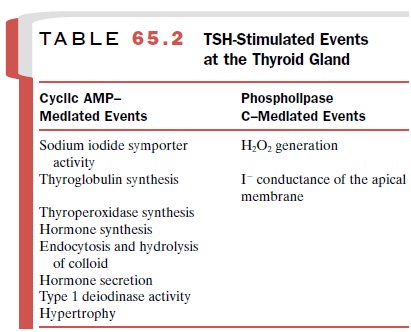Chapter: Modern Pharmacology with Clinical Applications: Thyroid and Antithyroid Drugs
Mechanisms of Action of Thyroid Hormones
MECHANISMS OF
ACTION OF THYROID HORMONES
Thyroid hormone mechanisms of
action can be classi-fied into two types: (1) genomic or nuclear and (2) nongenomic,
including effects at the plasma mem-brane and mitochondria. Genomic effects
involve modi-fication of gene transcription, are mediated only by T3,
and require at least several hours to detect. Nongenomic actions are generally
rapid in onset and occur in response to T4 and some T4
metabolites (e.g., rT3, T3, and T2).
Genomic Actions of Thyroid Hormones
Thyroid hormone receptors are members of a super-family of nuclear
receptors that includes receptors for estrogen, glucocorticoid,
mineralocorticoid, retinoic acid, 9-cis-retinoic acid (retinoid X), and vitamin
D. Similar to the mechanism of action of lipophilic steroid hormones, the
lipophilic T3 binds to a protein receptor to form a complex and the
hormone–receptor complex binds to an appropriate hormone response el-ement on
DNA to alter the transcription of specific genes. The current view of the
mechanism of thyroid hormone action differs from that for steroid hor-mones,
however, in three major ways: (1) There are ap-parently no cytosolic receptors
for thyroid hormones. (2) The nuclear TRs can bind to DNA nucleotide se-quences
in the regulatory region of thyroid hormone– responsive genes in the absence of
thyroid hormone binding. (3) In the absence of T3 binding, TR bound
to these specific areas of DNA may repress or promote the transcription of the
associated thyroid hormone-responsive gene.
Nongenomic Actions of Thyroid Hormone
The nongenomic actions of
thyroid hormone are in-creasingly recognized as physiologically significant.
Nongenomic actions may be observed within minutes of stimulation and respond to
a range of thyroid hormone metabolites (T4, T3, rT3,
T2). The magnitude of nonge-nomic actions is usually only a few fold
in contrast to the multifold genomic actions. The nongenomic actions (Table
65.2) may involve interactions with components of the cellular signal
transduction pathways, such as cyclic adenosine monophosphate (cAMP),
phos-phatidyl inositol, and protein kinases. Examples include effects on
cellular respiration, cell morphology, vascular tone, and ion homeostasis.
Possible nongenomic targets of thyroid hormone include the plasma membrane, cy-
toskeleton, sarcoplasmic reticulum, mitochondria, and contractile elements of
vascular smooth muscle.

Related Topics